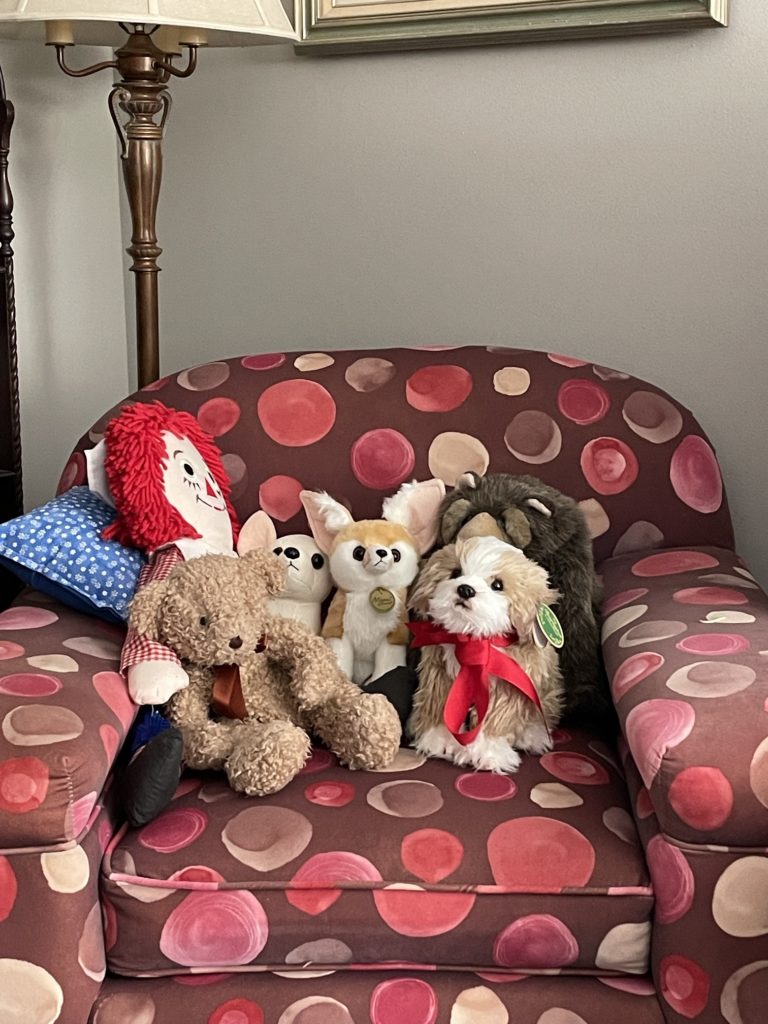Mom decided one day the government was holding her against her will and forcing her to do tests. We couldn’t convince her otherwise. For a time paranoia was definitely her destroyer.
As we cruised into the final six weeks, Mom entered a calm period, filled with overwhelming hallucinations but an awareness of their veracity and an appreciation for some of the more absurd moments. For example, we gave mom a stuffed dog, one that resembled an old cockerpoo she once had. Mom desperately wanted a real dog, but we begged her not to get a trip-hazard combined with a automatic adoption at the end. She settled on the stuff dog and we gave it to her for Christmas. And her cadre grew until her chair became a Toy Story-esque menagerie.

Raggedy Andy came to her from our brother who passed away in 2004. He must remain no matter what. The bears were given to her by Snapper at different times. And finally the chihuahuas came from her niece. Sitting in a polka dot chair from Mom’s childhood, these animals took one of the seats in the studio apartment, forcing someone to rest on the edge of the chair or stand to the side of it. And the whole time you’re there, Mom would pause her discussion to chastise one or more of the animals.
“Nelly. You leave Humphry alone!”
“Look at her; she’s kissing him. Now you stop young lady.”
“I know they aren’t real, but they’re real to me.”
We gave Mom as much leeway on the visions as we felt prudent, but eventually you have to say “it can’t hurt you because it isn’t real.” Experts tell you not to say that; let the delusion work its way through. But when she complained of a woman pulling snakes out of her belly button and how that was sort of frightening, we offered her a choice. We offered her a remote possibility for relief through quetiapine or haldol or xanax. All of them bring a risk of severe side effects ranging from lethargy to full blown psychosis for lewy body patients. While quetiapine seemed to help somewhat, despite our experience with Dad, the haldol actually began to help. But nothing worked for long.
During many of our conversations, Mom would stand up and walk away from the phone. I’d heard the sharp clack clack of her cane on the floor as she attempted to stamp out the serpents. She simply chose not to mention them after a while. And we convinced her the stuffed dogs could kill the snakes, which she appreciated but ultimately didn’t believe.
She called us more throughout the day to ask why she had to stay in her room. It was cruel to force her to sit in her chair and not move. She called me one day in a full panic and rage, demanding to know why we were so cruel to force her to sit n a chair taking tests by the government. Her stuffed animals now had cameras in them, recording her responses to questions asked by some shadowy figured in her china cabinet. Of course we never told her to stay in her room; she stayed out of paranoia but came to the conclusion it she was being kept against her will. This stage lasted a very short period, roughly the week after her 77th birthday.
“I can’t sleep. The snakes will get me,” she’d wail.
So we made the difficult decision to give her enough medicine to lower the stress, which of course resulted in more time in bed. But her frantic calls lessened and for a few days her sleep eased. The government man went away and snake woman disappeared. It was short-lived, only a few days, but we all got sleep those nights.
I’ll probably never get over the guilt of medication. Dad reacted to the helpful meds and Mom barely noticed them, apart from the morphine. Now morphine is a wonder drug as much as it’s a nightmare drug. Her hardest week was coming and hospice started showing signs of fatigue. The constant texting from us, the multiple visits throughout the week to keep Mom calm, and the sheer burden of providing care in an assisted living facility that was ill-prepared for a dementia patient wore all her caregivers down to a point.
Who would fall first? Mom, us, or hospice?